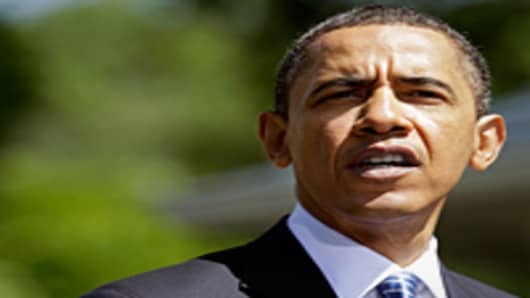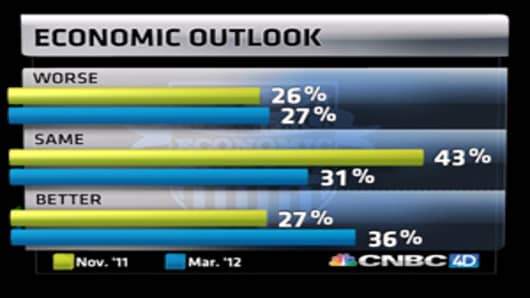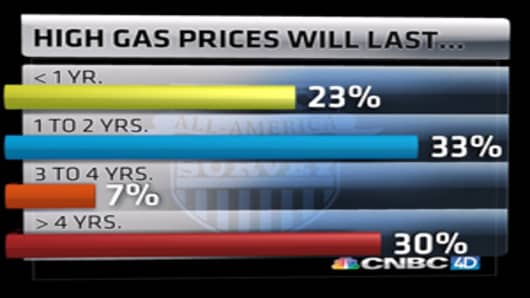While President Barack Obama leads Mitt Romney in most head-to-head polls ahead of November's general election, CNBC’s latest All-America Economic Survey shows the president is still vulnerable on critical pocketbook issues.
Most significantly, the CNBC survey found that just 28 percent of Americans say they are better off now than they were four years. Thirty-seven percent said they were better off before President George H.W. Bush lost his re-election bid in 1992 to Bill Clinton.
Fewer people deemed the economyin poor shape than was the case in the previous CNBC survey published in December.
Only 36 percent of the 836 people in CNBC’s poll conducted between March 19 to 22 said the economy would be better in the next year. By comparison, an NBC/Wall Street Journal poll conducted from Feb. 29 through March 3found that 40 percent believe the economy will improve during the next year, a three-point increase in that poll from January.
Overall, respondents in the CNBC survey held a poor view of the economy — with worries about jobs, gasoline and housing prices, as well as the budget deficit, continuing to drag on confidence. But a surprisingly low number said Obama was to blame.
"In this environment, the conventional wisdom is that this is a president who has absolutely no chance of being re-elected, but this is not the only consideration for voters," says Jay Campbell, a pollster and VP at Hart Research, which conducts the quarterly survey for CNBC.
The Blame Game
At the same time, the president’s supporters can take heart in the fact that more voters still blame former President George W. Bush for the financial crisis, recession and level of joblessness.
Twenty-eight percent blame Obama's predecessor for the recession, vs. 17 percent for Obama. About a quarter say Bush is to blame for the financial crisis, versus 13 percent for the president. On joblessness, 22 percent blamed Bush versus 21 percent for Obama. (The poll has a margin of error of plus or minus 3.4 percent.)
In this area, says Campbell, partisan politics is more of a factor, with roughly one in two Democrats (46 percent) blaming Bush. Nevertheless, 25 percent of independents picked the former president as well. In fact, Bush was blamed the most, over Obama, both parties of Congress, the business cycle and Wall Street.
Another plus for Obama is that a significant percentage of respondents say the financial crisis (25 percent) and the recession (16 percent) are the fault of Wall Street and the financial sector, with whom the president has frequently clashed and whose interests are generally perceived to be represented by the Republican Party.
The results in this area are surprisingly nonpartisan.
Thirty-one percent of Democrats blame Wall Street for the financial crisis, compared with 20 percent of Republicans. Independents registered 22 percent.
Results were roughly similar on the question of the recession. Democrats ranked first (19 percent; GOP and independent respondents were about equal (13 percent/14 percent).
The Election Outlook
Put together, the data may help explain why Obama still holds a solid edge over presumptive GOP presidential nominee Romney, the former governor of Massachusetts and venture capitalist. In a hypothetical, head-to-head matchup in the recent NBC/WSJ poll, Obama led 50 percent to 44 percent.
“Given that attitudes really are still fairly negative overall it’s surprising that Obama does not receive more blame than he does,” says Campbell.
Perhaps the most negative chord in CNBC's survey is Americans' overall view of the economy, almost two years after the official end of the recession.
More than half (53 percent) in the All-America survey described the economy as poor, and 35 percent said fair. In addition, 52 percent of respondents say they are worse off than four years ago.
“These are troublesome numbers for the president,” adds Campbell, noting that the better/worse combination is the poorest of six presidential election cycles dating to 1992. "But we know from other polling, the president has a solid core of support."
Still, the toss-up nature of the data is compounded by the poll results of key demographic groups, which have previously swung elections.
Only one in five suburban women voters felt better off, compared with 53 percent who felt worse off. The results were slightly better for independents (24 percent better, 57 percent worse), and blue-collar workers (28 percent/59 percent).
At the same time, however, those feelings appear to have little correlation to the voting intentions of the three groups. Obama leads Romney with independents (46 percent to 39 percent) but trails him with the blue collar group (41 percent to 50 percent), according to the March NBC/WSJ poll. The two candidates are essentially tied among suburban women.
The Gasoline Equation.
The Gasoline Equation
The stubbornly high level of negativity about the economy almost certainly has many sources, but the most prominent one of late has been the steady rise in gasoline prices, an extremely powerful factor among voters at the lower-end of the income scale, who are also the most likely to have static wages.
Analysts say gasoline prices, now averaging just under $4 a gallon, may be the wild card in the election, especially as both the labor and housing markets show signs of stabilization or improvement after prolonged malaise.
Gasoline prices were the top concern of 28 percent of the CNBC respondents, the same as health care. For people with incomes between $30,000 and $50,000, it was 33 percent.
The percentages were even higher for those in the South (35 percent) and who identified themselves as blue collar (38 percent), two weak spots for Obama.
When prices last hit this level in the summer of 2007, the presidential election was still more than a year away. Nevertheless, Bush’s approval ratings fell to a low of 29 percent that June.
Obama’s performance approval rating has never been that low (its bottom was 44 percent in August 2011), and he has always been popular on a personal basis. Still, aside from its recent blip and another around the time of Osama bin Laden's killing, the president's ratings have been below 50 percent since spring 2010.
“The president is the guy in charge and the incumbent will always have to answer to some degree for the state of the economy,” says Campbell. "But, as the saying goes: Is an election a choice or a referendum?"







